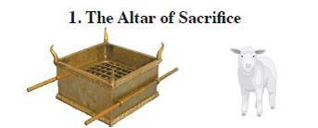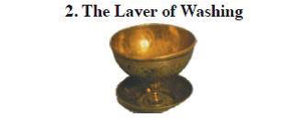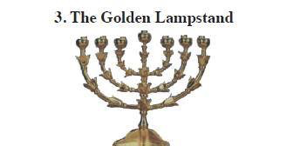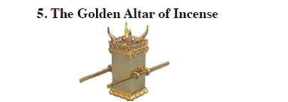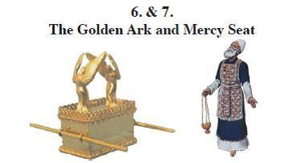Tabernacle Primer
TABERNACLE LARGE MODEL DISPLAY · Thursday, February 16, 2017
A Picture of “Good things to Come”
A Picture is Worth a Thousand Words
The tabernacle was a sacred tent where God’s presence dwelt among Israel as they journeyed through the desert from Egypt to their promised land. As a tent (unlike their future temple) it was portable and could be moved from spot to spot as Israel travelled.
The details and order of the tabernacle are recorded in the Old Testament Holy Scriptures (Exodus 25-40). The New Testament Scriptures call the tabernacle a “figure” (illustration) of “good things to come” – God’s good news concerning His Son, Jesus the Christ (Hebrews 9:9, 11). In modern times we often communicate with graphics and so does God.
The tabernacle was enclosed by a white wall. There was one door to enter. It was on the east side (the rising of the sun).
There were 3 sections:
- The outer courtyard;
- The first sanctuary, the holy place;
- The most holy place inside the veil where God appeared.
There were 7 pieces of furniture:
- The altar of sacrifice;
- the washing laver;
- the lampstand;
- the table of bread;
- the altar of incense;
- the ark and its lid;
- the mercy seat.
Let’s see the New Testament graphical meaning.
The wall was made of fine twined linen (white) and enclosed the courtyard and the sanctuary. If the biblical measurement of a “cubit” is indeed one and one half feet, then the wall formed a rectangle 150 feet long (half the size of a football field) and 75 feet wide (Exodus 27:9-15).
If there was no wall, then the graphic would communicate that all are born with close access to God. But the wall formed a barrier to God’s presence. Simply put, God was on the inside and man was on the outside. The Son of God taught that there is a barrier between man and God: “Ye shall … die in your sins: whither I go, ye cannot come” (John 8:21). God is pure and holy and man is impure and sinful.
The wall did, however, have a gate (door) of access. And there was only one. The one gate was made from cloth of four colors: white, blue, scarlet red and purple. It hung on four pillars forming three equal openings to the one door (Exodus 27:16).
The wall was not meant to keep people away from God but to show the approach to God is single.
Though a wall keeps out, a door lets in. If there was no door then the graphic would show that because God is holy, man could never come to him. If there were several doors then the picture would convey that there are many ways to God.
But one door says one way. The Son of God said: “I am the door: by me if any man enter in, he shall be saved, and shall go in and out, and find pasture.” “Jesus saith unto him, I am the way, the truth, and the life: no man cometh unto the Father, but by me” (John 10:9, 14:6).
- The four pillars of the gate remind us of the four gospels of Jesus Christ that present Him as the one Savior for the four corners of the world.
- The three sections remind us of the one triune God: Father, Son and Spirit.
- The four colors remind us of the character of Christ.
- White linen tells us He’s the sinless One.
- The heavenly blue that He’s God’s only Son;
- The purple says that He as king shall reign,
- The scarlet says He for our sins was slain.
God gave the specific order for the arrangement of the furniture (Exodus 40:20-38). If you could trace a line around their divine order the following would appear. (The ark and mercy seat are two pieces forming one).
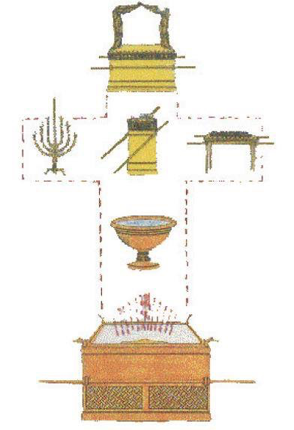 Interesting shape!!!
Interesting shape!!!
The tabernacle and its rituals are called a “shadow of good things to come”; the salvation of Jesus Christ – of which He is the substance (Heb. 9: 9-11, 10:1, Col. 2:17). Many still focus on religious rituals rather than receiving the reality – The Lord Jesus Christ as their Lord and Savior. They are chasing shadows. They are like a husband who sees the shadow of his bride appearing as she is ready to walk down the aisle. He then ignores his bride and embraces her shadow.
Are you chasing shadows or have you embraced the only living Savior?
The first piece a worshipper would encounter as he came through the door was the altar. It was wood covered with brass (or copper at that time). It was a perfect square with horns on each of the 4 corners. It was where the blood sacrifices of clean lambs would be offered in the heat of fire unto God for atonement (the covering and forgiveness of sins) (Exodus 27:1-8, Leviticus 17:11).
Since the brazen altar was FIRST, it tells us that judgment on sin and forgiveness must come first in one’s approach to God. If the courtyard had been set up with no altar or priest to offer the sacrifice, it would convey that one could come into God’s presence without a sacrifice or mediator. Some religions teach this way. But the altar says our sin must be dealt with first by God’s ordained Priest. It was the Son of God who on the cross sacrificed His sinless blood on behalf of the sinner; “Christ died for our sins.” “Behold the Lamb of God, which taketh away the sin of the world” (1Corinthians 15:3, John 1:29).
It was Jesus who was resurrected as the High Priest. When people receive the Lord Jesus Christ by faith, they are taking their place as a sinner under judgment and trusting Christ alone as their Savior before God.
The equal four sides of the altar remind us that the gospel of Christ is nondiscriminatory. For God so loved the world (north, south, east and west) that He gave His only begotten Son, that whosoever believeth on Him should not perish but have everlasting life” (John 3:16).
The four horns speak of power. The blood of Jesus Christ has power to forgive all sin (1John 1:7, 9).
The second piece of furniture was a washing basin for the priests called the laver (lavatory -place of washing). It came after the altar of sacrifice and before the entrance to the sanctuary. It was made of polished copper. Its purpose was “to wash.”
The priests had to daily wash their hands and feet from dirt and contamination before they served God at the altar or entered the sanctuary to worship. The laver was not for the shedding of sacrificial blood for sin but for the washing of dirt. One had to be clean to serve. (Exodus 30: 18-21).
This second piece tells us that God is not only interested in the forgiveness of our sin but also our daily cleanliness in living for Him. The New Testament teaches that once one is forgiven of sin by Christ’s sacrifice he or she receives the “living water” of the Holy Spirit. One purpose of the Spirit is to renew our minds to serve God acceptably. We also read of “the washing of water by the word.” As the Christian daily learns God’s Word, the Bible, he or she is cleansed from wrong thinking and ways so his service is acceptable to God. (John 8:37-39, Romans 12:1,2. Hebrews 12:28, Ephesians 5:26, Psalm 119:11).
If the order was the laver first and the altar second, the picture would convey that Christ’s gospel says to live clean and then God will forgive and make one right. Many religions proclaim this order. But God’s order reveals that first God forgives by Christ and then He gives the power (Spirit) for one to live clean unto Him.
The Holy Place
(The First Sanctuary or room – with 3 Pieces of Furniture)
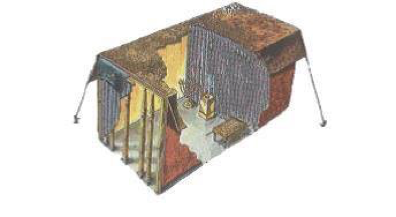
The holy place contained gold, not copper:
- the golden lampstand,
- the golden table of bread and
- the golden altar of incense.
Here the washed priests entered to perform service and representative worship unto the Lord. This section tells that God is not only interested in our forgiveness and daily cleanliness but also our worship.
On the south side of the holy place stood the pure golden lampstand. The gold was formed into the shape of an almond tree in the full bloom of life by beating or hammering. It had six fruitful branches with a central shaft or trunk. They were designed to hold seven bowls filled with olive oil to provide light. Light and life merged together in one unit. The light was continual and was never to go out.
There was no light at all in the holy place except that which came from the golden lampstand. The varied colors and beauty of the inner sanctuary could only be seen in this one light. John 1 presents the one Christ (Jesus) as both light and life. “In Him was life; and the life was the light of men.” He alone as God in the flesh gives life eternal and the light to understand and know God.
The number six of the branches reminds us of man (created on the sixth day). The number seven of the lamps reminds us of God’s perfect number (resting the seventh day for all things were completed and good). Jesus Christ is both six (man) and seven (God) in one person.
The church of the Lord Jesus Christ is also pictured as a lampstand through which His Spirit and Word reveals the gospel, truth and glory of God (Revelation 1:20).
Directly opposite the lampstand stood the table of showbread on the north side. One could only see the bread by the one light. Twelve loaves of bread were set on it once a week. During the week the bread was to be displayed before God. On the Sabbath the priests were to eat it. Thus God and man shared the same table together in fellowship of the same bread.
A table is a place where friends fellowship while eating. We read of the “Lord’s table” in the New Testament where the Christian breaks the bread and eats it in the fellowship of the body of Christ (1Corinthians 10:16-21). Here God and man are in harmony over the same thing: the sacrifice of Jesus Christ. His death was pleasing to the Father as an acceptable offering for our sin and His death is precious to us as the means by which we are forgiven and know God’s love (Romans 5:8).
The third and last piece of furniture in the holy place was the altar of incense with its four horns. This stood by the veil which separated the holy place from the holiest of holies. This altar was for one purpose only: to burn incense, not sacrifice. The incense was a special God-prescribed formula which sent out a rich fragrant smoke when the priest lit it at morning and evening.
Incense pictures prayers to God (Psalm 141:2, Revelation 5:8, 8:3). When one prays in the name of God’s Priest (Jesus) there is power and it is a pleasing aroma to God.
The Holy of Holies
(The 2nd Sanctuary or room with 2 Pieces of Furniture)
The holiest place of all contained the ark of the covenant covered with a special lid called the mercy seat. This was where God’s presence resided and where He communed (talked) with Moses (Exodus 25:22). The veil or curtain blocked the way so others could not enter in.
However, the minute the Lord Jesus died on the cross the veil, then in the temple, was split in two showing the way was now made now for all to come into communion with God (Matthew 27:51, Hebrews 9:7, 8, 10:19-21).
The ark was a chest made out of wood covered with gold and sporting a crown border like the table and incense altar. It, however, rested in the holiest place where the presence of God dwelt. The chest contained
- the two tablets of the Ten Commandments: God’s standard of righteousness
- a golden pot of manna: God’s provision to sustain His people
- and, Aaron’s rod that budded with life: God’s choice of who would be priest to mediate for His people (Hebrews 9:4).
The ark is a striking picture of where God’s presence now dwells: “For in Him [Jesus] dwelleth all the fulness of the Godhead bodily” (Colossians 1:19). Wood reminds us of His earthly manhood while the gold, of His heavenly divinity.
The crown pictures Christ as God’s coming King. God’s law was in His heart as He lived righteously. The Lord Jesus is God’s spiritual manna or bread to sustain life eternally and He is God’s one choice as High Priest to be our continual mediator and intercessor (Psalm 40:6-10, John 6:51, Hebrews 4:14).
The mercy seat was the cover of the ark. It was solid gold beaten into winged cherubim; one at each end looking down where God’s presence was. Cherubim are involved with the protection of God’s holiness. Here, once a year, the high priest alone went in with sacrificial blood from the brazen altar to sprinkle it on the mercy seat to obtain forgiveness of sins for Israel.
The mercy seat tells us there is mercy with God. The sacrifice of Christ is God’s mercy seat (Romans 3:25). “Neither by the blood of goats and calves, but by His own blood He [the Lord Jesus] entered in once into the holy place [heaven], having obtained eternal redemption for us [all believers]” (Hebrews 9:12).
